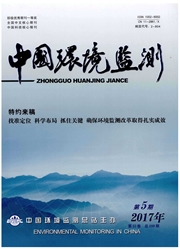

 中文摘要:
中文摘要:
利用GIS空间分析与统计方法,从景观尺度和类型尺度两方面分析了流域景观格局空间分异对河流高锰酸盐指数( CODMn )、氨氮、总氮( TN)、化学需氧量( CODCr )的影响。信江流域的景观组成对CODMn、氨氮、TN、CODCr浓度存在显著影响,耕地和建设用地的面积比例与各项指标浓度间存在显著正相关,林地与各指标浓度存在显著负相关。各项指标在流域上游变化不大,而在流域的下游变化显著。从景观尺度上看,流域景观以少数大斑块为主或同一类型的斑块高度连接时,河流中 CODMn、氨氮、TN、CODCr浓度较低,水质较好。从流域类型尺度上看,各类型的景观结构对河流中CODMn、氨氮、TN、CODCr浓度影响不同,建设用地以及耕地的集中大面积彼此相临的连片分布会导致河流中CODMn、氨氮、TN、CODCr等浓度的升高,而林地则表现出相反的效应。
 英文摘要:
英文摘要:
Using the GIS spatial analysis and statistical methods to explore the influnce of the landscape composition, spatial landscape pattern (landcape-level and class-level) on river water quality at CODMn, NH3-N,TN and CODCr. Reults showed that the landscap compositions of Xin river influenced water quality in CODMn, NH3-N,TN and CODCr, precentage of arable land and built-up land was positively related to these projects, while precentage of forestland showed a negative relationship, otherwise, all indicators concentration changed little in the upstream watershed, while in the downstream watershed changes significantly. At landscape-level, the aggregated the water quality was good when the size of patch was big. But at class-level, the aggregated distribution of the built-up land and arable land might cause CODMn, NH3-N, TN and CODCr concentration increased. But the aggregated distrubtion of forestland had the opposite effect on water quality indicators.
 同期刊论文项目
同期刊论文项目
 同项目期刊论文
同项目期刊论文
 期刊信息
期刊信息
